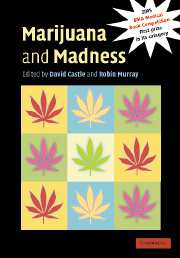Book contents
- Frontmatter
- Contents
- List of contributors
- Foreword
- Preface
- 1 The cannabinoid system: from the point of view of a chemist
- 2 How cannabis works in the brain
- 3 Acute and subacute psychomimetic effects of cannabis in humans
- 4 The association between cannabis use and depression: a review of the evidence
- 5 Cannabis and psychosis proneness
- 6 Is there a specific ‘cannabis psychosis’?
- 7 Cannabis as a potential causal factor in schizophrenia
- 8 Cannabis abuse and the course of schizophrenia
- 9 The endogenous cannabinoid system in schizophrenia
- 10 Cannabinoid ‘model’ psychosis, dopamine–cannabinoid interactions and implications for schizophrenia
- 11 Motives that maintain cannabis use among individuals with psychotic disorders
- 12 Addressing cannabis abuse in people with psychosis
- 13 Residual cognitive effects of long-term cannabis use
- Index
- References
2 - How cannabis works in the brain
Published online by Cambridge University Press: 07 December 2009
- Frontmatter
- Contents
- List of contributors
- Foreword
- Preface
- 1 The cannabinoid system: from the point of view of a chemist
- 2 How cannabis works in the brain
- 3 Acute and subacute psychomimetic effects of cannabis in humans
- 4 The association between cannabis use and depression: a review of the evidence
- 5 Cannabis and psychosis proneness
- 6 Is there a specific ‘cannabis psychosis’?
- 7 Cannabis as a potential causal factor in schizophrenia
- 8 Cannabis abuse and the course of schizophrenia
- 9 The endogenous cannabinoid system in schizophrenia
- 10 Cannabinoid ‘model’ psychosis, dopamine–cannabinoid interactions and implications for schizophrenia
- 11 Motives that maintain cannabis use among individuals with psychotic disorders
- 12 Addressing cannabis abuse in people with psychosis
- 13 Residual cognitive effects of long-term cannabis use
- Index
- References
Summary
Important advances have been made in the past decade in understanding how cannabis affects the brain. As with morphine 20 years earlier, research on the psychopharmacology of a plant-derived drug led to the discovery of a naturally occurring cannabinoid system in the brain, whose functions are only now beginning to be understood. This chapter will review what is known about the interactions of cannabis with the cannabinoid system in the brain and how the drug affects psychomotor, cognitive, perceptual and appetitive functions. There is also speculation on what brain mechanisms may underly the intoxicant effects of cannabis, and a review of its addictive properties.
Cannabinoid receptors
In Chapter 1 the identification of Δ9-tetrahydrocannabinol (THC) was reviewed as the principal active component in the complex mixture of cannabinoids present in extracts of the plant Cannabis sativa, and the discovery of a series of naturally occurring endogenous cannabinoids (endocannabinoids), of which anandamide has so far been most intensively studied, was outlined. A series of synthetic cannabinoids – some of which are more potent and more water-soluble than THC – is also available (Pertwee, 1999) (Fig. 2.1). All of these compounds act as agonists at the CB1 cannabinoid receptor (Matsuda et al., 1990), which is the only one known to be expressed in the brain. A second cannabinoid receptor, CB2, is expressed only in peripheral tissues, principally in the immune system (Munro et al., 1993; Felder and Glass, 1998; Pertwee, 1999).
- Type
- Chapter
- Information
- Marijuana and MadnessPsychiatry and Neurobiology, pp. 19 - 40Publisher: Cambridge University PressPrint publication year: 2004
References
- 2
- Cited by



